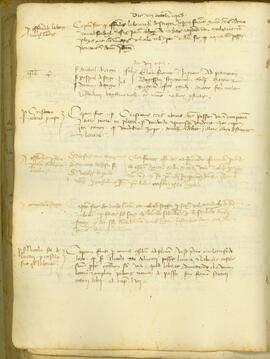Identity area
Reference code
Title
Date(s)
- 1415-1652, 1656-1809 (Creation)
Level of description
Series
Extent and medium
117 volumes; textual records
Context area
Name of creator
Archival history
Immediate source of acquisition or transfer
Content and structure area
Scope and content
The series contains the decisions of the Minor Council made in the period from the beginning of the 15th to the beginning of the 19th century. With the cessation of Venetian rule in 1358, the Minor Council and the Rector lost much of their authority. Since then, the Council had mostly dealt with cases related to communal life, that is, it would resolve current affairs that should not burden either the Senate or the Major Council. From today's point of view, it could be said that the Minor Council had executive authority. The Rector, whose mandate lasted only one month, was at the head of the Minor Council and he presided over both the Senate and the Major Council. The Minor council headed by the Rector represented the Republic and held audiences with ambassadors from foreign countries. In cooperation with the Senate, the Minor Council oversaw all correspondence with the consuls of the Dubrovnik Republic, ambassadors (poklisari) and other diplomatic and consular representatives of the Republic in foreign countries, mostly in the Ottoman Empire and in the countries of the Apennine Peninsula. The Minor Council was also in charge of issuing letters to foreign rulers and other dignitaries.
The series contains a lot of information about Jewish people. The data are very important to analyse the attitude of the Dubrovnik Republic towards Jews. The series also provides a large quantity of data to learn about their private lives, as well as about the business of Jewish merchants. In addition, the series is extremely important for the research of private and business lives of Jewish women. The first information about Jews in this series dates to the 20s of the 14th century with, for example, a reference about a Jew by the name of Chrisomus who sold a bell and some copper in Dubrovnik (1428; vol. 4, f. 192v). Bandit attacks on Jews who travelled to Dubrovnik using the ships of the Republic and, most likely, intended to go this way to the Ottoman Empire, at the end of the 15th century, are referenced many times. There are many references in this series to well-known figures from the Sephardic world some of whom only passed through Dubrovnik, and some lived there such as Gracia Mendez and her business representatives Abner Alfarin and Isac Ergas, physicians Amatus Lusitanus, Abraham and his son-in-law Joseph Salama, a poet Didacus Pyrhhus, a merchant Daniel Rodrigues (16th century), a rabbi Aron Cohen (17th century), and a merchant Raphael Cohen (18th century). The series also contains information about sending Jewish physicians, especially Abraham and Joseph Salama, to the courts of Ottoman dignitaries in Bosnia and Herzegovina. Through the decisions of the Minor Council, we can, for example, follow the destiny of the members of the Dubrovnik Jewish community during the court trial against a Jewish merchant Isaac Jeshurun, accused of a ritual murder of a girl from Dubrovnik (1622). If in fear for their own lives, many Jews were allowed to leave Dubrovnik with a special permission of the Minor Council. The series also contains many documents in which free arrival and limited stay to Jewish merchants who were in debt were granted (Lat. salvus conductus). This council would also issue permits for construction projects in the ghetto and for housing purposes outside the ghetto. Occasionally, the Minor Council would also make decisions on the obligation imposed upon Jews to wear a special sign. The series mentions many Jewish women, most often widows, who were given permission by the Minor Council to perform certain legal work with the consent of their guardians. Most often, these were women who wanted to appoint a certain person to represent them to conduct business either in the Dubrovnik Republic or in another country.
Appraisal, destruction and scheduling
Accruals
System of arrangement
Conditions of access and use area
Conditions governing access
Conditions governing reproduction
Language of material
Script of material
Language and script notes
Physical characteristics and technical requirements
Finding aids
Građa za generalni katalog Državnog arhiva u Dubrovniku, box 3, folder 8. Josip Gelčić, »Catalogus i. r. Archivii Ragusini.« Glasnik Zemaljskog muzeja u Bosni i Hercegovini 22 (1910): 537-588. Index partium Minoris Consilii ab. a. 1783. (d. 2. Junii) ad a 1790 (HR-DADU-4.1, vol. 116). Riccordanze dei Signori Consiglieri dell’ Illustrissimo Minor Consiglio 1608. a quei dell’anno 1686. (HR-DADU-4.1, vol. 117). Istruzioni per i Magistrati per procedere a norma degli Statuti e delle antiche consuetudini (HR-DADU-14.1, vol. 16).
Allied materials area
Existence and location of originals
Existence and location of copies
Related units of description
Publication note
Konstantin Vojnović, »O državnom ustrojstvu republike dubrovačke.« Rad JAZU 103 (1891): 24-67. Ilija Mitić, Dubrovačka država u međunarodnoj zajednici (od 1358. do 1815) (summary: The Dubrovnik State in the International Community (from 1358 to 1815), Zagreb: JAZU - Nakladni zavod Matice hrvatske, 1988. Jorjo Tadić, Jevreji u Dubrovniku do polovine XVII stoljeća (résumé: La Communauté Juive de Dubrovnik), Sarajevo: La Benevolencia, 1937. Miroslav Pantić, »Izbor dokumenata o dubrovačkim jevrejima od sredine XVII do kraja XVIII veka.« Zbornik Jevrejskog istorijskog muzeja 1 (1971): 341-402. Vesna Miović, Židovke u Dubrovačkoj Republici (summary: Jewish Women in the Dubrovnik Republic), Zagreb-Dubrovnik: HAZU Zavod za povijesne znanosti, 2013. Zdenka Janeković-Römer, The Frame of Freedom. The nobility of Dubrovnik between the Middle Ages and Humanism, Zagreb - Dubrovnik: Zavod za povijesne znanosti HAZU u Dubrovniku, 2015. Vesna Miović, Židovski rodovi u Dubrovniku (1546-1940) (summary: Jewish Families of Dubrovnik (Ragusa), 1546-1940), Zagreb-Dubrovnik: Zavod za povijesne znanosti HAZU u Dubrovniku 2017.
Notes area
Alternative identifier(s)
Old reference code
Access points
Subject access points
Place access points
Name access points
Genre access points
Description control area
Description identifier
Institution identifier
Rules and/or conventions used
Status
Level of detail
Dates of creation revision deletion
2021
Language(s)
- English

